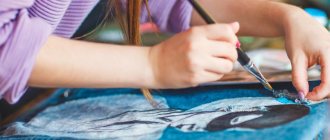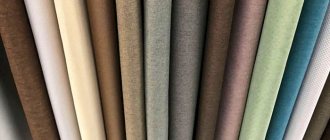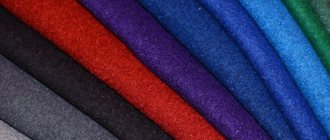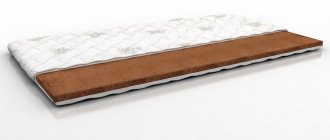What colors are used to paint on clothes? What material is suitable for working with them? Acrylic paints are ideal for applying to fabric and leather. How to fix a drawing? How to draw and paint on clothes correctly so that the images do not fade longer and retain their original appearance? To do this, you need to learn about the techniques and features of working with such paints on fabric.
Advantages
Many artists decide to paint with acrylic paints based on their advantages, which include:
- rich assortment, availability;
- safety in use;
- the ability to use water as a diluent;
- water resistance of the coating of patterns on fabric (can be soaked and washed);
- Resistant to machine wash.
In addition, acrylic paint is suitable for creating multi-colored patterns because the pigments mix easily, allowing you to create new shades.
Pros of hand-painted clothing
There are many of them:
- you definitely won’t meet anyone wearing the same T-shirt/sweatshirt/jacket as yours;
- this way you can save a lot: plain clothes without a pattern (base) cost much less than things with prints;
- in such an outfit you will undoubtedly attract attention;
- in such a simple way you can express your individuality;
- and of course, this way you can unleash your creative potential, show your imagination, express your taste and preferences.
So, cast aside all fears and doubts: even those who last held a brush in a school art lesson will be able to independently create an exclusive outfit for themselves or as a gift to a loved one the first (maximum the second) time. Believe me, drawing on fabric, on clothes, on things is easier than painting pictures.
Photo: Anastasia Babakova, personal archive
Where to begin? With inspiration! Where to look for it? Yes, even on the Internet! There are many ready-made master classes on painting clothes on the Internet. They are aimed at different levels of training and creative skills. Review them and just look through the pictures (in the same Yandex pictures, on pinterest.com or depositphotos.com, for example).
However, don’t get too carried away with looking at other people’s works; at the initial stage, this can play a cruel joke on you. And here’s why: after looking at the work of professionals in this field, those who have already “painted” a hundred or two T-shirts and denim jackets, you can lose faith in your own abilities or “pick up” someone else’s style of drawing.
And don’t immediately start “creating” portraits in the style of hyperrealism and copying famous paintings by great artists (unless you have a professional art education). Start with simple drawings, maybe in pop art style, in a “cartoon” style. In a word, those that are easy to redraw. By the way, there are several life hacks that make drawing/redrawing designs on fabric much easier (but more about them in the second part of the article).
Video: Anastasia Babakova
Fabric for work
Is it possible to paint with acrylic on different fabrics? If we talk about choosing material for beginners, then it is permissible to use various textures for working with ordinary acrylic.
You can draw on any materials: thick textiles, denim, thin silk, cotton or linen.
But it should be remembered that the structure of the painted areas will have a denser texture than the rest of the canvas.
Select by fabric type
Depending on the composition, the painting features and the result change:
- Natural cotton, linen or semi-synthetic fabrics can be dyed well at home. The maximum amount of synthetic fibers in the material should not exceed 50%. The more synthetics, the lighter the finished shade;
- Synthetic fabrics are not dyed or dyed unevenly, with spots;
- Silk and viscose are dyed in cool water, gradually heating to almost boiling;
- Wool, leather, fur are suitable for painting.
There are several types of paints for dyeing and painting clothes on the market.
Simplicol
This is the name of German paints, characterized by a rich range of colors and high quality of color fixation in one step. Simplicol is intended for different materials:
- Natural fabrics in warm water;
- Silk, coarse types of wool, polyamide in hot water above 60⁰С;
- Underwear made of nylon, perlon (high temperatures produce rich colors, low temperatures produce delicate colors).
Universal paint "Tekhnokhim"
Dye made in Russia. Effective on linen, cotton, viscose, silk materials, as well as on fabrics with an unknown composition. The color is bright, juicy, and preserves well.
Dylon
They dye tulles, clothes made of silk, cotton, linen, and wool. Perfect for hand coloring, even without heating. Following the instructions, you will get a rich shade. To preserve it, the item is rinsed in a weak vinegar solution.
Dylon
Javana
Used for painting silk and synthetic items. Elegant decoration is done with a thin brush, and voluminous decor is done with a sponge or aerosol can. Fix the design with a hot iron, ironing it from the wrong side for 3 minutes.
JAVANA
Jacquard
Used for decorating textile materials. The acrylic composition is diluted with water, penetrates well into the fibers, colors evenly, and attracts with a variety of colors.
Preparatory work
Painting on fabric with acrylic paints requires some preparation. Before you paint, you need to do the following with the base material:
- immerse in cold water for one hour, then rinse under the tap;
- dry and iron with a warm iron.
If you paint on fabric with a fine texture (cambric or silk), it is advisable to stretch it on a wooden frame until it dries.
If you decorate a piece of clothing and draw on clothes, it is recommended to separate one layer from the other with cardboard or thick paper.
How to dye fabric
To paint the material in the desired shade, just buy the paint and carefully prepare for the procedure.
Preparing for work
Before dyeing, be sure to soak the product for an hour in cold water and then wash it by hand. If you want to apply a design to the fabric, dry it after washing and iron it with a not too hot iron. Remove zippers, fasteners, buttons, Velcro and other accessories, if possible.
Required Tools
The exact list of necessary tools will depend on the dyeing method and the chosen dye. In general, you may find it useful:
- pencil for contouring;
- various brushes;
- copy paper;
- cotton swabs and disks;
- frames and stencils;
- clean cloth;
- wooden sticks or large tongs;
- enamel pan.
Manual method
If you want to paint a small area of the item, use spray paint. The coloring process will be as simple as possible and will not take much time. Shake the bottle thoroughly and spray the paint on the desired area of fabric at a distance of 20–30 cm. The longer you hold the trigger, the brighter the color you will get.
If the material needs to be painted completely, before work, be sure to read the instructions for use and paint dosage on the package.
Don't forget to put on rubber gloves before painting.
Description of work:
- Dissolve the paint in water according to the dosage and heat to a certain temperature.
- To soften the water, add 2 teaspoons of soda to the coloring composition.
- Add 2 tbsp to the solution. spoons of calcined or table salt.
- Place the product in the dye mixture and hold for 30–40 minutes, periodically turning over and straightening the fabric.
- Adjust the dye exposure time based on the desired intensity of the final color.
If you want to change the color of several items at once, paint them one by one.
Machine washable
First of all, check the instructions for the dye to see if it can be used in a washing machine. If there are no restrictions, you can start painting. Progress:
- Dilute the paint in water according to the instructions.
- Place the product in the drum, carefully straightening out all the folds.
- Add 2 teaspoons of soda to soften the water.
- Start the wash cycle in warm water, temperature 30–40 degrees.
- When the machine has finished filling the wash water, open the powder compartment and add dye.
If after the procedure there are still streaks on the fabric, put the product back in the drum and turn on the rinse and spin cycle.
Types of painting
There are the following techniques for painting with acrylic on fabric:
- hot and cold batik;
- free painting (with and without saline solution);
- shibori or folded batik;
- knotted batik.
Subtleties of painting technique
Painting with acrylic on different materials requires the following subtleties:
- Despite the fact that it is possible to dilute the contents of tubes with water, craftsmen often use solvents, since this has a better effect on the adhesive properties of acrylic.
- To protect the treated area of the material, polyethylene or oilcloth is placed under it.
- To make the pattern on the fabric clearer and acrylic to be applied more easily, it is preferable to use brushes with synthetic bristles. In this case, each subsequent layer must be applied when the previous one is completely dry.
- How to pin an image? Artists advise fixing the dye with an iron no earlier than 24 hours after application.
- Light shades are applied first, and each subsequent layer should be darker than the previous one.
How to paint on a T-shirt with acrylic paints
High hiding, opaque and durable acrylic paint is ideal for home fabric painting
For those who, like many professional designers, have chosen acrylic paints for their own decoration, we will tell you how to paint on T-shirts at home using acrylic paints. The creative process is divided into several stages:
- Washing the product before painting . This will allow the material to better absorb the paint and avoid the pattern “moving to the side” after the first exposure of the knitwear to water.
- Pulling things onto a backing . The tension should not be very strong, but it is necessary so that the brush does not pull the material when drawing stripes. The backing will also prevent paint from soaking into the back of the item. Fastening can be done with office clips, clothespins and even tape.
- Drawing the outline of the future image . This can be done with a simple pencil or felt-tip pen on fabric, by hand, or by placing a sample of the design under a T-shirt. Knitwear is easily translucent, so the pattern will be visible.
- Coloring the picture . Apply light colors first, then dark ones. How can you draw on T-shirts? To do this, use cotton swabs, sponges and various brushes. Thin lines are best painted with natural brushes.
- Outlining and drying . You need to trace very carefully so that the lines are clear and even. And acrylic paint dries quite quickly.
- Securing the drawing . After heating the iron to a temperature suitable for the material of the product, iron the design from the inside out.
Where do they draw on T-shirts? This can be both the front and the back. Here are 2-6 stages of the drawing process
As you can see, the process of creating an exclusive item at home is not that complicated. And the future owner chooses what to draw on a white T-shirt himself, depending on the presence or absence of drawing skills.











